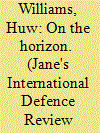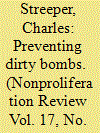|
|
|
Sort Order |
|
|
|
Items / Page
|
|
|
|
|
|
|
| Srl | Item |
| 1 |
ID:
060613


|
|
|
|
|
| Publication |
Fall-Winter 2004.
|
|
|
|
|
|
|
|
|
|
|
|
|
|
|
|
| 2 |
ID:
175078


|
|
|
|
|
| Summary/Abstract |
Since September 11, 2001, most expert commentary on radiological weapons has focused on nonstate actors, to the neglect of state-level programs. In fact, numerous countries in the past have expressed interest in radiological weapons; a number have actively pursued them; and three tested them on multiple occasions before ultimately deciding not to deploy the weapons. Why is so little known about these false starts, especially outside the United States? Are such weapons more difficult to manufacture than depicted by science-fiction authors and military pundits? Are radiological weapons a thing of the past, or do they remain an attractive option for some countries? A comparative analysis of the previously underexplored cases of radiological weapons programs in the United States and the Soviet Union illuminates the drivers and limitations of weapons innovation in one specific nuclear sector. An examination of the rise and demise of radiological weapons programs in both countries also points to circumstances in the future that might prompt renewed interest on the part of some states in radiological weapons and proposes steps that might be undertaken to reduce the possibility of their production, deployment, and use.
|
|
|
|
|
|
|
|
|
|
|
|
|
|
|
|
| 3 |
ID:
125779


|
|
|
|
|
| Publication |
2013.
|
| Summary/Abstract |
With the likes of Reaper and Shadow now established on the modern battlefield, manufactures and operators alike are looking at what comes next. Huw Williams canvasses the opinion of some of the leaders in the field and looks at what the future may hold.
|
|
|
|
|
|
|
|
|
|
|
|
|
|
|
|
| 4 |
ID:
132204


|
|
|
|
|
| Publication |
2014.
|
| Summary/Abstract |
Recent studies have taken an important first step in examining which terrorist groups, based on their organizational characteristics and the characteristics of the environment in which they operate, are more likely to pursue chemical, biological, radiological, and nuclear (CBRN) weapons. This approach, however, assumes that individuals who perpetrate events act on behalf of the organization to which they primarily belong. Using the case of Jemaah Islamiyah's alleged attempt to develop the pathogenic bacterium Bacillus anthracis, or anthrax, the authors demonstrate the importance of including individual-level variables to the analysis. In particular, the attendance by several key Jemaah Islamiyah members at an Al Qaeda-affiliated training camp is argued to set a chain of events into motion that ended in their involvement in the anthrax cultivation program.
|
|
|
|
|
|
|
|
|
|
|
|
|
|
|
|
| 5 |
ID:
099518


|
|
|
|
|
| Publication |
2010.
|
| Summary/Abstract |
Radioactive sealed sources have a long history and a much wider worldwide distribution than do weapons-usable fissile materials. This article compares the mechanisms for controlling radioactive sources with those of weapons-usable materials and makes the case for improved policy making on the safe and secure management of radioactive sources (often referred to simply as "sources"). Such sources have been widely distributed with commercial and government support to nearly every country, yet there are no legally binding, international agreements or regulations to control any aspect of their life cycle. This is problematic because some sources that are disused, abandoned, or otherwise fall out of regulatory control could be used in the form of a radiological dispersal device (RDD, or dirty bomb). An RDD could pose significant economic and psychological impacts with the potential for detrimental effects on public health. The lack of international measures to control sources is troubling for several reasons: creating an RDD is much easier than fashioning a nuclear weapon from scratch or from stolen fissile materials; given the many incidents involving diversion from regulatory control and the misuse of sources, an RDD attack would be one of the more likely scenarios; materials security for sources is generally weak and inconsistent; it is nearly impossible to determine the total amount of sources manufactured and distributed; used sources are frequently found uncontrolled and transiting borders, and penalties are light at best; the market-based supply and demand of sources facilitates their rapid and loosely regulated distribution; and the "peaceful uses" aspect of the Treaty on the Non-Proliferation of Nuclear Weapons along with norms that began developing around the time of Atoms for Peace have promoted the nearly unchecked global distribution of sources. Several immediate and long-term actions are suggested to reduce the threat posed by radiological sources.
|
|
|
|
|
|
|
|
|
|
|
|
|
|
|
|
| 6 |
ID:
182649


|
|
|
|
|
| Summary/Abstract |
most media and academic attention has focused on mass shootings and other deadly conventional attacks, far-right non-state actors have also considered developing chemical, biological, radiological, and nuclear (CBRN) weapons. Some far-right extremists have suggested using radiological devices, often referred to as “weapons of mass disruption,” as one means to achieve their ideological goals. Although radiological plots and successful attacks have rarely occurred, the presence of unsecured radioactive sources across the United States augments the danger of this type of terrorism. To explore dimensions of the radiological-weapons threat posed by domestic far-right extremists, this paper studies three illustrative cases of possible radiological-weapons pursuit since 2008, aiming to identify lessons from these incidents. An in-depth examination of the cases reveals foremost that some actors successfully acquired materials needed for a radiological weapon without triggering intervention by authorities. Additionally, although the individuals did not plot in large, hierarchical groups, they had links to other people and organizations that shared their far-right views and allegedly discussed their plans with others. While broad generalizations cannot be made from three cases, these incidents provide concrete examples of the far-right radiological-weapons threat and context for understanding how far-right extremists view the role of CBRN weapons.
|
|
|
|
|
|
|
|
|
|
|
|
|
|
|
|
| 7 |
ID:
077914


|
|
|
| 8 |
ID:
167798


|
|
|
|
|
| Summary/Abstract |
Drone swarms—multiple unmanned systems capable of coordinating their actions to accomplish shared objectives—have major implications for the future of warfare. One important set of implications relates to the ability of drone swarms to complement, challenge, and even substitute for chemical, biological, radiological, and nuclear (CBRN) weapons. For example, swarming drones might enable more effective CBRN delivery. Or they might facilitate standoff detection, search the oceans for nuclear-armed submarines, or otherwise impede an adversary’s ability to threaten or employ CBRN weapons. Conventionally armed drone swarms might serve as strategic deterrents in lieu of CBRN weapons. At the same time, many CBRN-relevant applications of drone-swarm technology entail significant technical challenges even for very sophisticated states, and even more so for non-state actors whose capabilities will be far more limited, so there is considerable uncertainty around whether, how much, and when drone-swarm technology will complement, challenge, or substitute for CBRN weapons.
|
|
|
|
|
|
|
|
|
|
|
|
|
|
|
|
| 9 |
ID:
036939


|
|
|
|
|
| Publication |
New York, United Nations. Department for Disarmament Affairs, 1989.
|
| Description |
xi, 207p.
|
| Standard Number |
9211421497
|
|
|
|
|
|
|
|
|
|
|
|
Copies: C:1/I:0,R:0,Q:0
Circulation
| Accession# | Call# | Current Location | Status | Policy | Location |
| 031379 | 327.17405/UNI 031379 | Main | On Shelf | General | |
|
|
|
|
|
|
|
|
|